Essential Commands You Can Teach Your Dog
Josh Billings once said: “Dog is the only thing on earth that loves you more than he loves himself. Bringing home a pet for the first time can be a heart-touching moment. Seeing your new four-legged friend, your new baby yawn and make adorable faces around you is a moment which you will remember for years as he grows up. He will be your new favorite hobby, one that will be on all your latest selfies and group photos.
After the moment of “oohs and aahs” from your friends, families, and neighbors have passed, you will start wondering about training your pup to grow up to be a perfect gentleman.
- How to train a dog to stay in the yard?
- How to I train him to shake hands?
- How do I make him go to his kennel?
- Train him to fetch
- Make him to smile
will be some of the common dilemmas you would be hit with.
Though we often compare our pups with our babies, raising a dog may require more efforts at the beginning than a child. Whether you are a dog owner or an amateur trainer, this guide will help you learn the important skills you need to train your dog to learn the basics of how to stay in the yard, smile, shake hands, and respond to his name.
I. Things you will need for the training
- A few flags and a clicker – The flags are used to mark the boundaries for your dog and the clicker is to signal your dog that he has done the right thing by staying within the boundaries of the flag and that he will be rewarded for the same.
- A 30 to 50-foot long leash – A long leash is an alternative method of training your dog to stay within the boundary or the designated yard. It also ensures that your dog doesn’t run off during the yard training.
- Dog Treats – Treats such as biscuits, chew sticks, toys, or chicken chunks should be used to reward your dog every time he behaves like a good boy and returns to you after touching the boundary limit, i.e. the flags.
- A dog Toothbrush – A toothbrush can come in very handy if you wish to teach a dog to smile as most of them are used to showing their teeth when they see their toothbrush. This trick is useful only if your dog is already familiar with the concept of brushing his teeth and knows his toothbrush.
- A dog whistle – Dog whistles are a handy tool when training your dog to learn commands such as “sit,” “stand,” “stop barking,” and “come.” The sound produced by the whistle may seem normal to the human ear but for dogs, it is a startling sound grabs their attention even when your voice can’t.
- A crate or a kennel – Crate training is another significant part of your dog training. And, to train to get into his kennel, you must first build or buy a kennel that suits your dog regarding space, height, and comfort.
II. 5 essential commands you can teach your dog
#1 – Teach Your Dog to Stay in The Yard
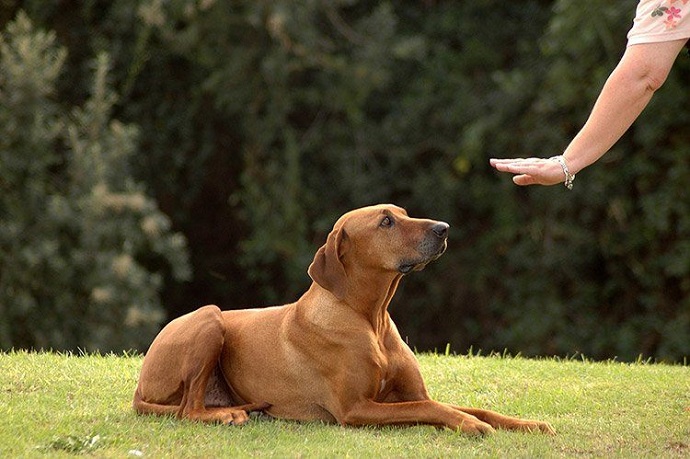
Guaranteeing that your pet stays within your yard and doesn’t run off is a significant part of dog training. This not only prevents from any accidents or injuries to him but also eradicates the possibility of him being dognapped.
- Start indoors by marking a boundary within your house using the flags and teach your dog to touch the flag by pointing it to them repeatedly.
- Every time they are successful at it, hit the clicker and call out their name to return to you. When they do, reward them with a treat.
- Start with one flag and then start placing such markers every 8 to 10 feet.
- Alternatively, use a long non-retractable leash which will give your dog enough room to roam around. Place flag markers around the yard and when your dog gets near one, use the clicker or a gentle blow on the dog whistle to command him to “come.” Reward him with a biscuit or a toy when he returns to you.
Important Tip:
Remember, the most vital part of this training is that you show proper authority to your dog. Maintain a confident posture and a stern voice. After a few weeks, replace the treats with a pat on the back or a belly rub. For best results, practice this throughout the day, whenever you get time.
Read More: Best Dog Training Collar
#2 – Teach Your Dog to Smile
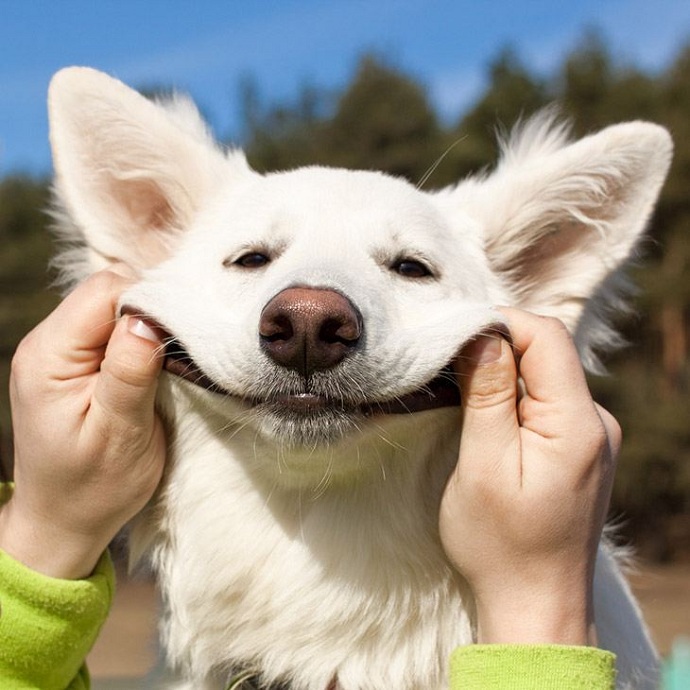
Teaching a dog to smile is one of the most challenging tasks in a dog training, however, when done accurately, it gives you a cute, smiley face to follow you around the house through the day.
- If your pup is familiarized with the concept of brushing his teeth, using a toothbrush to get him to show his teeth could be quite convenient.
- As soon as they see their toothbrush and show teeth, command them to “smile” with a happy, cheerful voice. Treat them with a reward for every successful action.
- If your dog is not used to brushing his teeth, start by creating a happy time for him. Play with him, take him for a good walk, or make him his favorite chicken dish.
- Once your dog is in a happy and relaxed mode, gently lift your dog’s lips on either side with your fingers and give the command “smile” in the same high-pitched, cheerful voice. As you do, treat them with a reward or a pat on the back.
Important Tip:
As mentioned before to teach a dog how to smile can be a bit daunting as compared to other training but the key is to keep repeating the commands several times a day (at least 10 to 15) and show encouragement to your pet every time he is successful at something.
#3 – Teach Your Dog to Give Paw
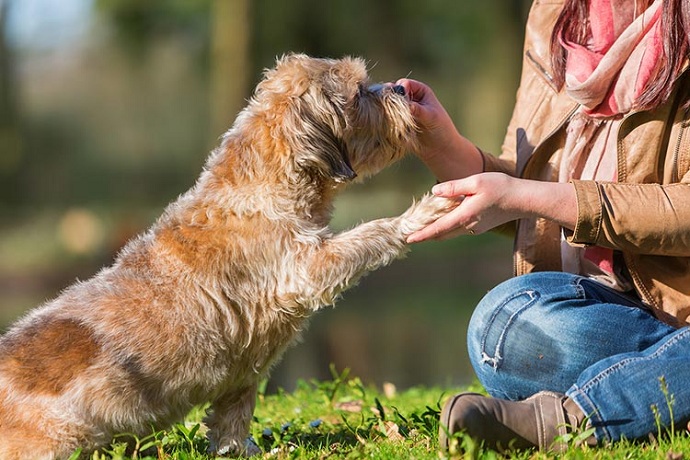
As compared to smiling, teaching a dog to give paw or shake hands is a fairly easy task, one that almost every dog learns in just a few days of training. To begin this training, all you need is your dog and a handful of treats. There are two different methods of training your dog to “shake”:
- Hold a treat in your hand and show it to your dog before closing your fist over the treat. Command your dog to “shake” by waving your hand close to his nose. Most dogs first sniff your hand and then try to paw your hand when they can’t get you to open your fist.
- The moment your dog lifts his paw and touches your hand, use the clicker and give a verbal cue such as “good boy” or “well done” before rewarding him with his treat. Practice this twice or thrice a day for 4-5 minutes, and your dog will be shaking hands like a pro before you know it.
- Alternatively, sit your dog and kneel in front of him all the while maintaining a straight and confident posture. Lay out your palm and command your dog to “shake hands.” Bring your palms closer to his paw as you repeat the command and as he puts his paw on your laid palm, treat him with a reward. Repeat the act a few times in a day with proper intervals.
Important Tip:
When kneeling down in front of your pet to teach him to give paw, pay proper attention to your posture. Don’t sit with a hunched back or talk in a low voice. Keep your back upright, chest out, and voice confident. It is very crucial to keep reminding your dog that you are his owner and that your authority is supreme and he must follow it.
#4 – Teach Your Dog to Fetch
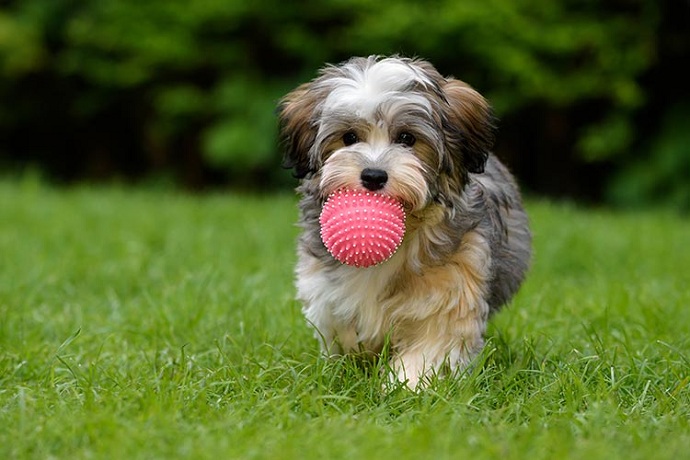
Teaching your dog to fetch a toy or a stick can be a fun experience, and it is almost always as easy as teaching him to shake hands. While most of us believe that “fetching” comes naturally to our buddies, it may require a bit of effort at your end.
- Start by ensuring that your dog is in a comfortable, seated position next to you. Use the “sit” command if need be. This way, your dog learns the basics of the game and doesn’t jump on you to try and get the toy.
- Once he is seated, throw the toy or ball or stick and command him to “fetch.” Start with shorter distance. Most dogs instinctively chase the toy thrown and pick it up. If yours does too, then your job is half done.
- The next step is to teach him to bring the toy back to you. For this, you need to ensure that your dog is strongly familiar with the “come” and “drop it” or “release” command. As soon as your pet picks up the toy, command him to “come” to you and “release” the toy. Reward him with a pat on the back or a treat on successful completion of the activity.
Important Tip:
Fetching may come naturally to your dog but getting him to come back to you and releasing the toy may seem a bit difficult. To achieve best results out of a game of fetching, ensure that your dog has a strong hold over basic commands such as “sit,” “fetch,” “come” and “release.”
#5 – Teach Your Dog to Go to His Kennel on Your Cue
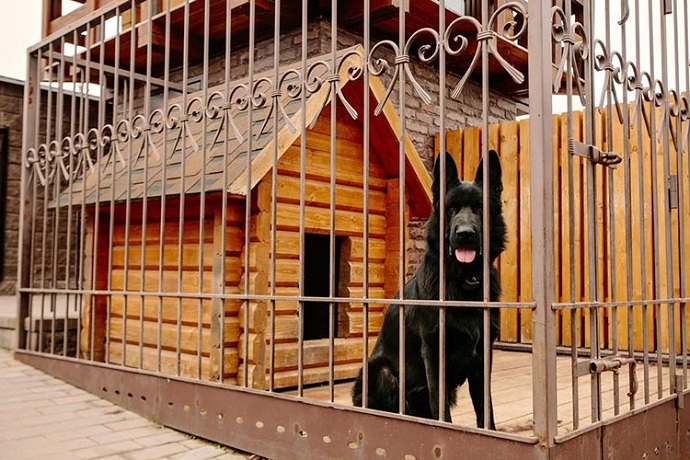
Though it may be fun to cuddle with your furry friend on a winter morning, it is also important for him to learn when to “kennel up.” It is imperative that you have a designated kennel or a cot or an area where your dog is supposed to rest when you have guests over, especially kids. Whether or not he stays in it all the time is another topic, but every dog must undergo a crate training.
- To start with kennel training, you need to first establish a cue word such as “kennel” “kennel up,” or “get in your kennel.” You may use any cue you want but ensure that your pet is known what you mean by pointing out the kennel to him while you teach him to get inside it as and when you command him to.
- Stand in front of the kennel and show him some treats such as a biscuit or a chew stick.
- Use the cue word and throw the treat inside his kennel. As soon as he walks into his crate, reward him with a “good boy” or another treat or by simply clicking the clicker.
- To ensure that he learns to stay in his kennel until told otherwise, use the “wait” command before you instruct him to come out.
Important Tip:
It may be easy to have your dog follow the “treat” to his kennel but to keep him inside until you say otherwise could be a bit of a challenge. To overcome this hurdle, it is important that your dog has a strong command over the “wait” and “come” instructions.
For best results, practice this a few times in a day for about 5-10 minutes each session. If your dog seems to be scared to get into the crate, try to make it comfortable by adding his favorite toys inside, keeping it open now and then, and decorating it with a comfortable bed. Remember not to force him inside as he may feel threatened or caged.
III. Conclusion
Training a pet may seem like a lot of work at first but once you have set the right tone and pace and once your dog learns the basic commands, the rest is guaranteed to be smoother and effortless.
With the help of above-mentioned tips and suggestions, you would be able to effortlessly train your dog to stay within your yard, to smile, to shake hands, to play fetch with you and even to get inside his kennel.
Once you have all the required means, training your pet to do just about anything you say should not be a concern at all. However, no matter whether you teach your dog to stay inside the fence or to sleep on his bed as opposed to yours, you need to display a figure of authority and command while providing him with instructions to follow.
At the same time, don’t forget to treat your pet every time he does something right. New toys, tasty meals, a walk in his favorite park, and a belly rub are some of the things you can use to encourage him. Last but not the least, treat him like your true companion because that is exactly what he will be for the next several years to come.
